Cards In This Set
| Front | Back |
|
What is clinically defined as hypertension?
|
An elevated blood pressure above 140/90.
|
|
What is the difference between primary and secondary hypertension?
|
Primary (essential) 90-95% of cases, where there is NO known cause, only lots of associated risk factors, and changing one of these factors wont rid you of hypertension. Eg genetics, age, diet, stress, smoking etc.
Secondary: 5-10% of cases where the cause is known. |
|
Are risk factors summative?
|
Yes, increasing your risk factors increases your chance of coronary heart disease.
Eg. Hypertension + raised cholestrol + smoking |
|
What are some examples of secondary hypertension?
|
Phaeochromocytoma: a tumour of the adrenal glands causing them to secrete higher levels of arenaline and noradrenaline leading to an increased blood pressure.
Renin-secreting tumour Cushings disease: increased secretion of corticoids Secondary hypertension is easier to treat as the cause is known. |
|
Hypertension can lead to a range of cardiovascular diseases, give some examples.
|
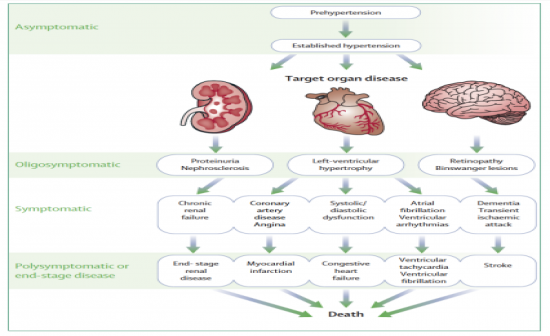 See Image. |
|
How does the artery wall structure change in hypertension?
|
1) Hypertrophy: thickening of the media smooth muscle cells
2) Increase in collagen 3) and decrease in elastin causing stiffness The thick and stiff artery walls make the artery less able to respond to changes in blood pressure eg during exercise. In smaller arteries may also see fibrinoid necrosis which blocks the arteries and hence increases resistance. |
|
What is malignant hypertension? give some examples.
|
Malignant hypertension is the terminal end phase of hypertension.
Such as HT retinopathy, sever ischaemia, thrombosis, and firinoid necrosis of the arterioles. |
|
What are some of the factors that influence primary (essential) hypertension?
|
- Heredity
- Diet - Age - Obesity - Stress - Diabetes - Smoking - Alcohol Intake These factors have an additive effect. Hypertension can also be reduced by managing these risk factors. |
|
How does the body respond to a decrease in blood pressure and blood volume?
|
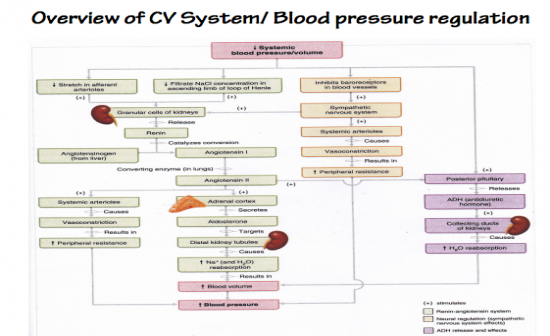 See Imagae. |
|
Outline the mechanism of Aldosterone mediated hypertension.
|
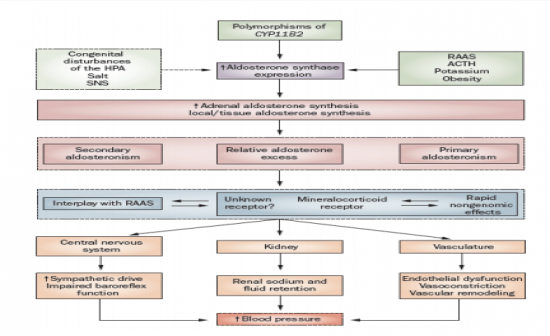 See Image. |
|
How does the nervous system control blood pressure?
|
The baroreceptor reflex: baroreceptor nerves notmally maintain homeostasis.
However in hypertension the baroreceptor reflex is reset to a new higher level. We can cure hypertension by returning the baroreceptor reflex back to normal levels. |
|
How does salt effect hypertension?
|
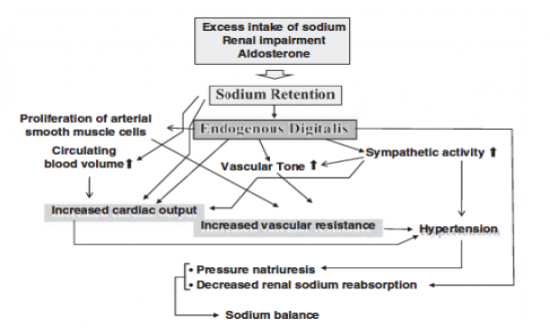 Increased salt intake increases blood pressure by retaining bodily fluids (increases extracellular fluid volume) Very fine line: 3g of salt = hypertsion 1g of salt = no hypertension Hence it is critical to stick between 1-3g of salt per day Increased salt = Increased hypertension. Unless you are genetically salt-resistant, then no hypertension. |
|
What diet was recomended by Kempner in 1948 to reduce hypertension?
|
The rice diet.
|
|
What did Goldblatt's 1934 clamped kidney experiment show?
|
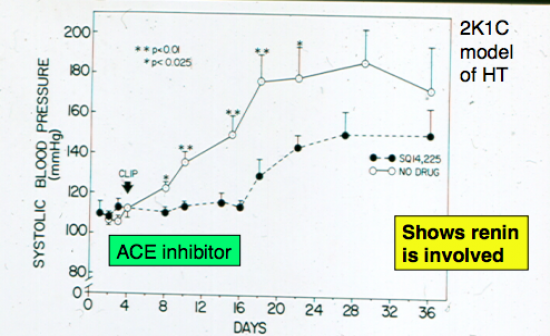 With one kidney clamped and other removed you see great hypertension - renin is not involved. Whith one kidney clamped but the other still intact you see less hypertension (resembles renal artery stenosis) When the two kidney model was injected with ACE inhibitor, the blood pressure droped dramatically, showing the involvement of renin in the two kidney model but not the one kidney model. |
|
Describe Guytons (1970) whole body autoregulation theory?
|
- The Kidney is the cause of hypertension. And hypertension involves resetting the pressure-diuresis relationship.
He suggested three possible causes for hypertension which are mutually exclusive: 1. Non renal: wrong 2. Non renal - Renal damage: wrong 3. Renal YES. |



